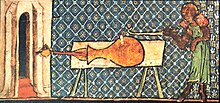Walter de Milemete
Walter de Milemete , also Millemete, was an English parish priest and scientist in the county of Cornwall . He lived at the beginning of the 14th century .
plant
De Milemete made the for King Edward III. handwriting determined by England De Nobilitatibus, Sapientiis, et Prudentiiis Regum ("On fame, wisdom and education of kings"). This and another manuscript De secretis secretorum Aristotilis are of particular importance due to the oldest known depictions of cannons ( arrow rifles ) from Europe. They showed guns in the form of thick-bellied, narrow-necked vases, which are stored on four-legged wooden racks ( carriages ), have loaded a rifle arrow as ammunition , which is spherical at the lower end, and are ignited with a glowing rod (a man in armor is shown holding the Stick to the arrow rifle). Obviously they wanted to blow up a gate with the rifle. Both manuscripts were created around 1326. The guns shown show similarities with a preserved gun barrel, the so-called Loshult rifle, from the holdings of the State Historical Museum in Stockholm .
The first references to the manuscript were published by the Austro-Hungarian-British explosives expert and explosives historian Oscar Guttmann in 1904. He found it in the library of Christchurch College in Oxford after hearing a reference to the Indologist Gustav Salomon Oppert in his book on military affairs in ancient India ( 1880) had read.
The book itself is not about military technology, but, as the title suggests, about government art. The dating results from the mention of the entry into government of Edward III. (given in the manuscript as 1326, according to today's calendar 1327). Due to the delicacy of the illustrations, Guttmann dated the creation to at least from 1325. The illustration can be found on the last page of the manuscript, without further explanation.
Guttmann was an advocate of the gun's German origin and suspected that they might have gone to England with the troops of Wilhelm III. who helped the wife Isabelle of Edward II to overthrow her in 1326 (his successor Edward III ascended the throne in 1327). According to Guttmann, the manuscript also explains a passage in the biography of Robert Bruce by John Barbour (1375), who wrote that in 1327 a new kind of noisy war device was first seen in Scotland ( crakys of wer ).
literature
- Oscar Guttmann: The oldest document on the history of gunpowder . In: Zeitschrift für Angewandte Chemie , Volume 17, 1904, pp. 1060-1061
- Wilfried Tittmann: The gun depictions of Walter de Milemète from 1326/7 . In: Waffen- und Costumekunde , Volume 35, 1993, pp. 145–147
- Klaus Leibnitz: The manuscripts of Walter de Milemete . In: Waffen- und Costumekunde , Volume 34, 1992, pp. 117-131.
- Montague Rhodes James : The Treatise of Walter de Milemete “De Nobilitatibus, Sapientiis, et Prudentiis Regum” . Oxford 1913 (facsimile).
- Jochen Gartz: From Greek fire to dynamite. A cultural history of explosives . Verlag ES Mittler, 2007, ISBN 978-3-8132-0867-2 .
- MA Michael: The iconography of kingship in the Walter of Milemete treatise , Journal of the Warburg and Courtauld Institutes, Volume 57, 1994, pp. 35-47.
Web links
- The picture below is from Aristotle's De Secretis Secretorum manuscript and is ascribed to Walter de Milemete
- Wilfried Tittmann: Gun representations . (PDF; 2.8 MB)
Individual evidence
- ^ Bodleian Library MS. Christ Church College 92
- ↑ Signature formerly Holkham Hall MS 458, now British Library Add MS 47680
- ↑ Theodor Jakobsson: A gun find valuable in the history of weapons in the Army Museum of Stockholm . In: Journal for historical weapons and costume studies . No. 8 (1943-1944) , pp. 124-127 .
| personal data | |
|---|---|
| SURNAME | Walter de Milemete |
| ALTERNATIVE NAMES | Walter of Milemete; Gualterus de Milemete; Walter de Millemete |
| BRIEF DESCRIPTION | English pastor |
| DATE OF BIRTH | before 1327 |
| DATE OF DEATH | after 1327 |
